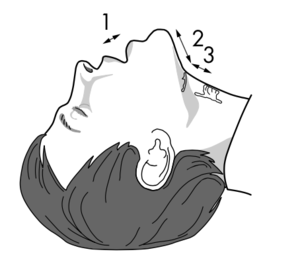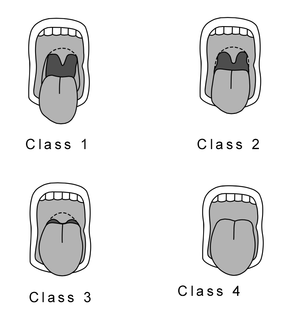Predicting the difficult airway
Difficult to Bag Ventilate
Difficult BVM (MOANS)
- Mask seal
- Obesity
- Aged
- No teeth
- Stiffness (resistance to ventilation)
Difficult to Intubate
A grade 3 on the upper lip bite test (patient unable to bite upper lip with lower teeth) has LR+ 14 for predicting difficult intubation[1]
LEMON
An airway assessment score based on criteria of the LEMON method is able to successfully stratify the risk of intubation difficulty in the emergency department.[2]
LOOK
- Look at the patient externally for characteristics that are known to cause difficult laryngoscopy, intubation or ventilation[3]
- Trauma
- Short neck
- Micrognathia
- Prior surgery
- May also be difficult to bag
- Body mass index
- Advanced age
- Beard
- No teeth
- Snoring
- Dentures
Evaluate 3-3-2-1

3-3-2 ruleDistance between patient's incisor teeth of 3 finger breadths and distance between the thyroid notch and the floor of the mouth should be at least 2 finger widths
- 3 - Ideally the distance between the patient's incisor teeth should be at least 3 finger breadths
- 3 - Distance between the hyoid bone and the chin should be at least 3 finger breadths
- 2 - Distance between the thyroid notch and the floor of the mouth should be at least 2 finger breadths
- 1 - Lower jaw should not sublux more than 1cm
Mallampati

Mallampati Score
- The patient sits upright, opens mouth and protrudes tongue
- Grades are based on visibility of the uvula, posterior pharynx, hard, and soft palate
Obstruction
- Assess for conditions leading to airway obstruction such as Peritonsillar Abscess (PTA), trauma, or Epiglottitis.
Neck Mobility
- Patient places chin down onto their chest and extend their neck.
- Remove the hard collar and provide manual stabilization in trauma patients.
- Poor neck mobility impacts ability to have airway access alignment.
See Also
References
- Detsky ME, Jivraj N, Adhikari NK, et al. Will This Patient Be Difficult to Intubate?: The Rational Clinical Examination Systematic Review. JAMA. 2019;321(5):493-503.
- Reed, M. et al. Can an airway assessment score predict difficulty at intubation in the emergency department? Emerg Med J. 2005 Feb; 22(2): 99–102. doi: 10.1136/emj.2003.008771
- Rennie LM, Dunn MJG, et al. Is the ‘LEMON’ method an easily applied emergency airway assessment tool? European Journal of Emergency Medicine 2004;11:154–7
This article is issued from
Wikem.
The text is licensed under Creative
Commons - Attribution - Sharealike.
Additional terms may apply for the media files.